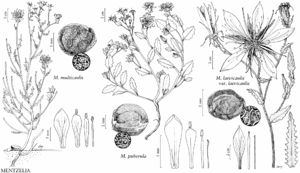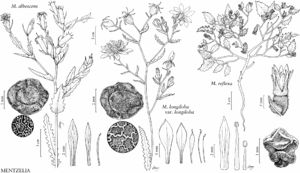Mentzelia
Sp. Pl. 1: 516. 1753.
Herbs or subshrubs [shrubs or trees], annual, biennial, or perennial; trichomes (1) pointed with surfaces ± smooth or antrorsely barbed and (2) retrorsely barbed along shaft and at apex or only at apex. Stems erect, clambering, or decumbent. Leaves basal and cauline or cauline; petiole present or absent; blade hastate, deltate, cordate, ovate, elliptic, lanceolate, linear, spatulate, oblanceolate, obovate, or orbiculate, lobed or unlobed, margins dentate, serrate, crenate, or entire. Inflorescences dichasia or flowers solitary; peduncle inconspicuous. Pedicels not elongating in fruit. Flowers: hypanthium adnate to ovary proximally, free distally; perianth whorls differentiated; sepals green, connate basally, lanceolate to narrowly ovate, shorter than petals; petals white, yellow, or orange, sometimes red proximally, distinct or connate basally, spatulate, ovate, elliptic, oblanceolate, or obovate, spreading to erect, glabrous or hairy abaxially, on margins, or on apices; nectary distal on ovary; stamens 8–45+, exserted or included; filaments monomorphic, filiform or dorsiventrally flattened and linear, or heteromorphic, outer dorsiventrally flattened and linear, elliptic, spatulate, or oblanceolate [lanceolate], inner filiform or dorsiventrally flattened and linear, longer than anthers; anthers without distal connective extension; staminodes present or absent; pistil 3-carpellate (5–7-carpellate in M. decapetala), placentae parietal; stigma lingulate, 3-lobed (5–7-lobed in M. decapetala), papillate. Fruits capsules, dehiscing by apical valves [splitting longitudinally], cupshaped, lingulate, subcylindric, cylindric, ovoid, urceolate, clavate, or funnelform, straight or curved, sometimes S-shaped; sepals persistent. Seeds (1–) 2–60+, ovoid, oblong, bottle-shaped, pyriform, irregularly polygonal, or trigonal prisms, dorsiventrally flattened or not, 0.5–4.5 mm, winged or not winged. x = 9.
Distribution
w, c, se North America, Mexico, West Indies, Central America, South America
Discussion
Species ca. 95 (85 in the flora).
Mentzelia is monophyletic and sister to subfam. Gronovioideae (M. L. Moody et al. 2001; L. Hufford et al. 2003). These studies recovered clades that correspond to the six described sections of Mentzelia, including the five treated here and the monospecific sect. Dendromentzelia Urban & Gilg, which consists only of M. arborescens Urban & Gilg of Michoacán and Oaxaca, Mexico.
Mentzelias in North America often are ruderal or found in low-productivity, disturbance-prone environments, such as arroyos, sand dunes, cliffs, or talus slopes. They frequently are associated with distinctive substrates, including gypsum, limestone, serpentine, or volcanic tuff, and some might be edaphically restricted (J. B. Glad 1976; H. J. Thompson and A. M. Powell 1981; C. M. Christy 1997; N. H. Holmgren and P. K. Holmgren 2002; Brokaw et al. 2015).
Changes in chromosome number, through both aneuploidy and polyploidy, have been important in the evolution of Mentzelia. Aneuploidy has been especially important in reproductive isolation in sections Bartonia (haploid chromosome numbers include 9, 10, 11, and 18) and Bicuspidaria (haploid chromosome numbers include 9, 10). In contrast, aneuploidy has not been found in sections Mentzelia or Trachyphytum, although polyploidy has been found in both. In sect. Mentzelia, polyploidy has been reported only in M. asperula. Polyploidy has played a more important role in reproductive isolation and diversification in sect. Trachyphytum, in which diploids, tetraploids, hexaploids, and octoploids have been reported (H. J. Thompson and H. Lewis 1953).
Floral forms differ among the sections of Mentzelia, which may be indicative of reproductive shifts that were important in the differentiation of the sectional lineages. Reproductive ecology has been investigated best in sect. Bicuspidaria, in which Xeralictus bicuspidariae, a robust oligolectic bee, is the main pollinator of M. hirsutissima, M. tricuspis, M. tridentata, and is one of three main pollinators of M. involucrata (G. S. Daniels 1970). Only M. reflexa, which has markedly different flowers compared to other species of sect. Bicuspidaria, is not pollinated by X. bicuspidariae. Instead, another oligolectic bee, Perdita koebelei, is its primary pollinator (Daniels). Bees have been suggested to be the primary pollinators of other sections of Mentzelia, except for the few large-flowered species of sect. Bartonia in which hawk moth pollination has been observed (H. J. Thompson 1960; A. R. Moldenke 1976; R. J. Hill 1977). Many polyploid species of sect. Trachyphytum have small flowers and reportedly self-fertilize (J. E. Zavortink 1966).
Seed surface features are important in Mentzelia taxonomy. In sections Dendromentzelia, Mentzelia, and Micromentzelia, which compose a basal grade in Mentzelia, seed coat cells are longer than wide. In contrast the derived clade consisting of sections Bartonia, Bicuspidaria, and Trachyphytum has seed coat cells that are polygonal and largely isodiametric. The shapes of anticlinal and outer periclinal walls of seed coat cells are similar in sections Bicuspidaria and Trachyphytum but differ among the other sections of North American species. Seed coat cell anticlinal wall shape, which is particularly useful in distinguishing species in sect. Bartonia, may be straight, wavy (curves along walls forming less than 45° angles), or sinuous (curves along walls forming at least 45° angles, often forming U-shaped undulations).
Leaf and bract margins in Mentzelia usually are toothed or lobed to some degree, ranging from serrate or dentate (divided relatively shallowly) through pinnate (defined here as divided partway to the midvein) to pinnatisect (divided nearly or to the midvein).
Selected References
None.
Lower Taxa
Key
| 1 | Stamen filaments all or mostly distally 2-lobed. | Mentzelia sect. Bicuspidaria |
| 1 | Stamen filaments unlobed, or 5 outermost distally 2-lobed and 5–15 inner filaments unlobed (Mentzelia micrantha, sect. Trachyphytum). | > 2 |
| 2 | Stamen filaments dorsiventrally flattened, 1–3(–5) outermost petaloid; seeds not winged. | Mentzelia sect. Bicuspidaria |
| 2 | Stamen filaments filiform or outer dorsiventrally flattened, inner filiform, 0 or 5+ outermost petaloid, if 5+, seeds winged. | > 3 |
| 3 | Ovules and seeds oriented perpendicular to long axis of ovary; seeds winged; 5 outermost stamen filaments usually petaloid, sometimes not. | Mentzelia sect. Bartonia |
| 3 | Ovules and seeds oriented parallel to long axis of ovary; seeds not winged (occasionally winged in Mentzelia lindleyi); 5 outermost stamen filaments not petaloid. | > 4 |
| 4 | Plants perennial. | > 5 |
| 5 | Leaf blades, at least some, with broad basal lobes, margins flat; capsules usually subcylindric, clavate, lingulate, or funnelform, sometimes ovoid; seeds oblong, ovoid, or pyriform, coat cells oblong. | Mentzelia sect. Mentzelia |
| 5 | Leaf blades without broad basal lobes, margins revolute; capsules ovoid to urceolate; seeds ovoid to bottle-shaped, coat cells polygonal. | Mentzelia sect. Micromentzelia |
| 4 | Plants annual. | > 6 |
| 6 | Leaf blades, at least some, with broad basal lobes; seeds oblong, ovoid, or pyriform, dorsiventrally flattened to trigonal, coat cells oblong, much longer than wide, anticlinal walls sinuous; basal rosette of leaves absent, proximalmost internodes 10+ mm. | Mentzelia sect. Mentzelia |
| 6 | Leaf blades without broad basal lobes; seeds triangular prisms or irregularly polygonal, coat cells polygonal, ± isodiametric, anticlinal walls straight; basal rosette of leaves present, persistent or not, proximalmost internodes to 5 mm. | Mentzelia sect. Trachyphytum |
"not elongating" is not a number.


